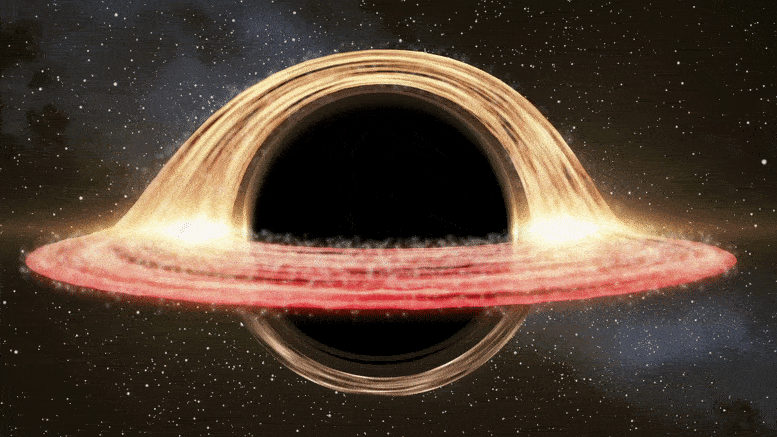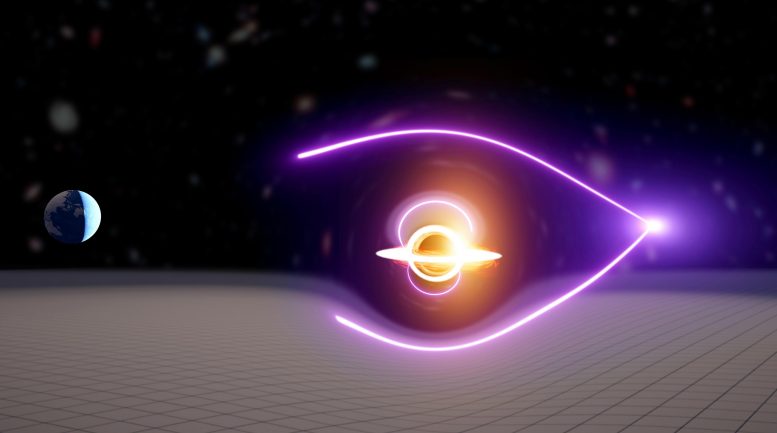
A recently discovered ‘Goldilocks’ black hole, approximately 55,000 times the mass of the sun, bridges the gap between small black holes from stars and supermassive ones found in galactic nuclei.
Black Hole Seeds Key to Galaxies Behemoths
A new black hole breaks the record — not for being the smallest or the biggest — but for being right in the middle.
The recently discovered ‘Goldilocks’ black hole is part of a missing link between two populations of black holes: small black holes made from stars and supermassive giants in the nucleus of most galaxies.
In a joint effort, researchers from the University of Melbourne and Monash University have uncovered a black hole approximately 55,000 times the mass of the sun, a fabled “intermediate-mass” black hole.
The discovery was published today in the paper “Evidence for an intermediate mass black hole from a gravitationally lensed gamma-ray burst” in the journal Nature Astronomy.
Lead author and University of Melbourne PhD student, James Paynter, said the latest discovery sheds new light on how supermassive black holes form. “While we know that these supermassive black holes lurk in the cores of most, if not all galaxies, we don’t understand how these behemoths are able to grow so large within the age of the Universe,” he said.
The new black hole was found through the detection of a gravitationally lensed gamma-ray burst.
The gamma-ray burst, a half-second flash of high-energy light emitted by a pair of merging stars, was observed to have a tell-tale ‘echo’. This echo is caused by the intervening intermediate-mass black hole, which bends the path of the light on its way to Earth, so that astronomers see the same flash twice.
Powerful software developed to detect black holes from gravitational waves was adapted to establish that the two flashes are images of the same object.

The new black hole was found through the detection of a gravitationally lensed gamma-ray burst. Credit: Artist impression: Carl Knox, OzGrav
“This newly discovered black hole could be an ancient relic — a primordial black hole — created in the early Universe before the first stars and galaxies formed,” said study co-author, Professor Eric Thrane from the Monash University School of Physics and Astronomy and Chief Investigator for the ARC Centre of Excellence for Gravitational Wave Discovery (OzGrav).
“These early black holes may be the seeds of the supermassive black holes that live in the hearts of galaxies today.”
Paper co-author, gravitational lensing pioneer, Professor Rachel Webster from the University of Melbourne, said the findings have the potential to help scientists make even greater strides.
“Using this new black hole candidate, we can estimate the total number of these objects in the Universe. We predicted that this might be possible 30 years ago, and it is exciting to have discovered a strong example.”
The researchers estimate that some 46,000 intermediate mass black holes are in the vicinity of our Milky Way galaxy.
Reference: “Evidence for an intermediate mass black hole from a gravitationally lensed gamma-ray burst” 29 March 2021, Nature Astronomy.
DOI: 10.1038/s41550-021-01307-1
Funding: Australian Research Council









Where is it? How far away?
It has a redshift distance of z ~ 1, which means it is halfway to the radius of the observable universe or was lensing the further out gamma ray burst when the universe was half today’s age.
Early enough to start becoming interesting as candidate for source of galaxy super massive black holes.
All black holes are born in the Center of Our Universe large, but over time they themselves give birth to billions of stars and become so small that they themselves become a star. At the same time, the gravitational connection with the Center of the Universe is lost and the galaxy breaks out of orbit and collides with another galaxy.
There is no “center” to our universe, see an astrophysicist’s description below.
The rest is wrong too.
“Despite the fact that we can see galaxies out to distances in excess of 30 billion light-years, if we track how everything is moving and reconstruct their trajectories back to a common origin, we see the most unlikely of outcomes: the perceived “center” lands right on us.
Our of all the trillions of galaxies in the Universe, what are the odds that we would just happen to be right at the center of the explosion that began the Universe? What are the odds, on top of those minuscule ones, that the initial explosion was configured in just such a way, complete with
– irregular, inhomogeneous densities,
– varying start times for star formation and galaxy growth,
– energies that vary tremendously from place-to-place in just the right, fine-tuned fashion,
– and a mysterious 2.7 K background glow in all directions,
to conspire so that we’re exactly at the center? There’s a lot we’d have to contrive to explain this and many observations would still remain inexplicable. The explosion scenario isn’t just unrealistic; it’s in defiance of the known laws of physics.
Instead, however, the law of gravity that governs our Universe — Einstein’s General theory of Relativity — predicts that a Universe full of matter and energy doesn’t explode, but instead expands. A Universe that’s full of equal amounts of stuff everywhere, with the same average densities and temperatures, must either expand or contract; since we observe an apparent recession, the expansion solution is the only one that’s physical.”
[ https://www.forbes.com/sites/startswithabang/2019/08/24/ask-ethan-where-is-the-center-of-the-universe/?sh=305931c85403 ]
The explosion scenario isn’t just unrealistic; it’s in defiance of the known laws of physics.
——————————————————————————————–
That’s what I’m talking about. There was no explosion – there was and continues the Great Synthesis. The diameter of our universe = 2 * 10 ^ 28 light years. This is the diameter from which gravity gathered the strings of the primary vacuum in one place. On for more the diameter- of the energy is not enough ( the constant Planck multiplied by the frequency does not allow. )
That was not what you were talking about, you were talking about a “center of the universe” which is a popular misunderstanding of the big bang expansion.
I’m not sure what an unobserved “synthesis” has to do with space expansion, in general relativity it is just a scale change in existing space [ https://en.wikipedia.org/wiki/Scale_factor_(cosmology) ]. Which explains why there is no “center of the universe”. That links also describe how the expansion scale up (at which rates and why those rates. If space is flat the expansion is spontaneous (an adiabatic free expansion).
Vacuum of space is not “strings” or “primary”, it is space. There is also no basic constraint on, say, photon frequencies.
The diameter of our universe is unknown. I quote from the linked article you seem to have not read at all:
“We don’t know what the actual size of the entire Universe is; we only have a lower limit that it must now be at least 46.1 billion light-years in radius in all directions from our perspective.”
Question.
Is it possible for a black hole to form BEFORE the ions unify into atoms at about 380,000 years?
All the protons are positive, so stay well away from the others. And the electrons are off doing their own thing, also repelled by the other electrons. So, how do you get the gravitational collapse when all the matter repels the rest of it? Something I don’t get? Probably! But what?
Thanks
All answers in the video (text translation):
https://www.youtube.com/watch?v=tFUM3vAlaGc
MY THEORY TOTAL:
TRANSLATION: Gravitation is a reactive traction of electromagnetic waves. Everyone knows that 2 ships can not move at a parallel course at close range because internal waves extinguish one another. while the outer ones continue to move away, pushing the ships towards (.28 sek)
It is also in atoms, and in other clusters of matter. So gravity works – outer waves go away, and internal ones extinguish one another .(0,28 – 1 ,05)
On the theory of Pavel Vasiliev: All planets are born by stars and are removed in spiral orbits, gradually cooled down. ( 1,07 – 1,27)
To this theory I would add. that all centers of galaxies (black holes) are born center of the universe and are removed in spiral orbits. Also, all stars are born in black holes in the centers of galaxies. ( 1,34 – 2,16 )
What started everything? From the vacuum! When the first strings of matter appeared – immediately there was a gravitation. and at Planck’s frequency (1875 * 10 ^ 43 Hertz), the gravity began to collect them in one place..Planck’s constant energy is multiplied by frequency. ( 2,28 – 3,24 )
The radius of the universe. Like the Sun and stars at a frequency of 10 ^ 14 Hertz hold matter within a radius of 2 light years, and the radius of galaxies at a frequency of 10 ^ 20 Hertz = 50,000 light years, we can conclude that at a frequency of 10 ^ 43 Hertz radius of the universe = 10 ^ 28 light years! (3,34 – 5.27 )
Is there one a universe? Are there a lot of universes? – I do not know that. The mass, according to the science, is 10 ^ 53 kilograms ( 5.27 – 5.46)
When the last star flies out of the center of the galaxy – the black hole itself becomes a star, but the connection, at a frequency of 10 ^ 32 Hertz, with the center of the universe breaks out and the galaxy goes into free navigation. Hence – the collision between the galaxies.(6,10 -6,55)
Also, the center of the universe (the big black hole) when the last black hole crashes out of it, it will become just a black hole – it will stop keeping all these galaxies at 10 ^ 32 Hertz. At this, the cycle of existence of the universe will end.( 6,55 – 7,32)
What can we all give it? For the solar system:
If on a plate of sodium having one line of the spectrum, give a frequency of oscillations of 10 ^ 14 Hertz – it will become weightless. Our earth draws in different directions, and the shape of the dish makes it possible to restrain.( 7,32 – 9,25)
In general, the development of the universe from the beginning and to the present day can be called in one word – SYNTHESIS. Of the strings – quarks in the Center of the Universe, from quarks – nucleons in turbulent holes, and from nucleons – all atoms in stars. So there was no Big Bang. There was a collection of matter in one place and synthesis from its small particles to larger ones and atoms. ( 9,25 – 11,00 )
And from the atoms, on the planets where the temperature and humidity allow, there is a SYNTHESIS OF LIFE, Life is a chemical reaction driven by electronic processors.( 11,00 – 11,34 )
A link to a video – likely your own – do not constitute a scientific theory [ https://en.wikipedia.org/wiki/Scientific_theory ].
You can’t get that pseudoscience published in peer reviewed science journals, so it won’t become a theory either.
Yes, it is possible to form primordial black holes out of early fluctuations in principle [ https://en.wikipedia.org/wiki/Primordial_black_hole ].
Most importantly is, I think, that the universe is neutral on average so charged volumes would be small if any. And if it happened at high enough energies the electromagnetic field may have not yet started to interact with matter in significant ways – there may have not been ordinary matter and gravitation may have acted only on the energy densities of the fluctuations.
More realistically, primordial black holes have two problems today. The fluctuations that would result from the favored inflation in the observed inflationary hot big bang theory wouldn’t be strong and dense enough. And many potential mass regions they could have are – ironically here – excluded by gravitational lensing studies.
Wonderlng if black holes becoming so heavy could eventually pierce the frame of our space-time.
Through the hole, some matter then escapes in another universe, and from this universe, the dark matter fill in ours.
And because of a principle of keeping some equivalence in the balance between both universes (ours, baryionnic, and the other made of dark matter), and because density per volume of dark matter is far lower than baryonnic matter, a large amount of dark matter fills in our universe, since the birth of the first black hole, expanding our universe dramatically, and making dark matter 95% of our universe.
What do you think?
It’s plausible! I like it!
I think the putative existence of so called “white holes” ending of black holes elsewhere used to be popular before estimates showed they wouldn’t work physically and have become impossible since 2018 when the observation of space being 3D flat has become reportedly robust enough observation to stay with us indefinitely. Then wormholes or black/white hole tunnels went “POP!” and disappeared where burst bubbles all go.
I also think you forgot that dark matter is not simply standard matter from another universe, and you have to explain why there is a difference in any case.
I should also note that if space is 3D there are no other universes, general relativity is self contained and with no more dimensions in play it describes all the space there can be.
Pog.
Simply fabulous!
… beautiful black wholes, are becoming ever more interesting…
The observation of the lens and its mass is straightforward, after using autocorrelation among ~ 3,000 archived gamma-ray bursts for the telltale “echo” of the lensed signal.
It is also the 3d candidate of similar mass observed in short order [the tidally fragmented star event of the 50,000 solar mass IMBH 3XMM J215022.4−055108, the active HLX-1 ~20,000 solar mass IMBH].
The problem is that the statistics they use to exclude a globular cluster lens says the lensing population seen here is 100 times as common, meaning the Milky Way neighborhood would have tens of thousands of IMBHs.
“Not everyone is convinced. One issue, said Natalie Webb, an astrophysicist at the Research Institute in Astrophysics and Planetology in France, is that we don’t know how many intermediate-mass black holes there are in the universe. How lucky would we have to be to have our planet perfectly line up with one such black hole and a gamma-ray burst? “Some people predict an enormous amount, 1,000 per galaxy, in which case this sort of thing would be quite likely to happen,” said Webb. “If you didn’t have such a large population, then yeah, it would be less likely.””
[ https://www.quantamagazine.org/decades-old-nasa-data-reveals-midsize-black-hole-20210329/ ]
Why did it get the name “goldilocks black hole? Dose it put off a gold glow or dose it have a gold hue to it? Also maybe or galaxy and universe as we know it really came out of a black hole (all galaxy’s with one in the center) and that’s why there is such strong gravity on planets because the matter was strengthendfrom passing through the black hole?
Jeez… why don’t you people learn to read, for f**k’s sake? All the answers are there – in books, and in real science-for-lay-people sites, like Phys.org etc. Just because an idea came to you when you were high doesn’t mean it’s an effin’ theory.
The black hole size is “just so” – it lies in the intermediate mass region where few candidates had been observed and it closes the growth gap from many times observed star massed black holes to many times observed super massive black holes.
From the very start of the article:
“A new black hole breaks the record — not for being the smallest or the biggest — but for being right in the middle.
The recently discovered ‘Goldilocks’ black hole is part of a missing link between two populations of black holes: small black holes made from stars and supermassive giants in the nucleus of most galaxies.”
I’m not sure I told it any better than they did, but that is the stated reason right there.
On reverse so called “white holes”, see my reply to Jean-raymond Ferrer the day before.
TL;DR: Nature doesn’t work that way. (But you need to do some heavy theory exercises to show why. The easy reason is because gravity always attract.)
Torbjornn, bashing someone and letting them know theire ideas are not going to be scientific threory is not only rude and unhelpful, it is very much in line with the pre scientific notions held by the church prior to the invention of the tekescope. If you personsonally could not find any wiggle room for the possibilities suggested by the author that is your limitations. The big bang theory which you probably based your lifes work on is riddled with problems and inconsistancies leading many new scientists to look at other possibilities, even though it has been so widely accepted as the best theory we have to date. The line of thinking presented by the author i believe is well within the lines of possible and the fact that it may never become theory as you so stubbornly reported is just wrong. You make no attempt to debate, disprove, or agree with any of it. If your words hold weight within the scientific community or shared, because dead end research never lead you or your colleages down a path to better explain the current Big Bang Theory it is a shame. Its how the truth is many times discivered. If any field of science should know by taking notes of just how wrong the past has been, it the field of astronomy.
Ernest, to use the sophistic response to an unneccessary response, “bashing someone and letting them know their comment is only “rude and unhelpful# is not only rude and unhelpful, it is very much in line with the pre scientific notions held by superstitions”.
The orioginal poster was linking to a self promotional video of pseudoscience, and erroneously claiming that consitutes a scientific theory, which is rude. It is also unhelpful for visitors that may also not know the difference between theories and pseudoscience.
And, as my referenced comments show, that is not my “personal [opinion]” but what the science says.
“The meaning of the term scientific theory (often contracted to theory for brevity) as used in the disciplines of science is significantly different from the common vernacular usage of theory.[6][note 1] In everyday speech, theory can imply an explanation that represents an unsubstantiated and speculative guess,[6] whereas in science it describes an explanation that has been tested and is widely accepted as valid.” [ https://en.wikipedia.org/wiki/Scientific_theory ]
And where do you get off pawning cosmology work on me!? I’m not a cosmologist, I have no skin in their immense and fascinating work, I’m just an interested bystander – with a modimum of science education, can be said, but that is not the issue here. People trying to insert pseudoscience into a science site is the issue – stick to that.
You are doing that too, whether or not you realise it. Your unreferenced claims on big bang cosmology is just that, since it is the accepted and observably ever more successful theory – as the article above show, say. Or by looking up the closest reputable encyclopedia:
“A wide range of empirical evidence strongly favors the Big Bang, which is now universally accepted.” [“Big Bang”, Wikipedia].
It is also evident that none of the pseudoscience is unpublished, same as similar pseudoscience.
I made every attempt to debate, disprove, and disagree with all of it – no one can agree with pseudoscience because it is not how nature works and it confuses people who may – like you – think it has something to do with actual science.
You may not agree with me, or with science and scientists, but you provided nothing supporting your opinion. I, at least, try to explain and reference the actual science. Maybe it is that education I claimed above, maybe it is because science is useful.
Errata:
““rude and unhelpful#” = “rude and unhelpful”.
“consitutes” = constitutes.
“modimum” = modicum.
Ernest Louis Lacaillade I support this opinion. A real researcher grabs any information to see further, and people like Torbjörn and Joseph reject everything – I did not teach this, there is no such thing in Wikipedia, so it can not be. And they don’t understand that people can come up with something new themselves.
Of course your opinion align with Ernest Louis Lacaillade’s. So what? It doesn’t make your unsupported ideas fact.
Re “Joseph”, you are confusing threads, I think.
Your opinions and ideas has exactly zero to do with “real research” of which you know nothing. I have used real researchers as references to show real science. And you just go on with your Dunning-Kruger idea that you are capable to understand any of science when you obviously are not [ https://en.wikipedia.org/wiki/Dunning%E2%80%93Kruger_effect ].
Match to the crackpot index:
“20 points for defending yourself by bringing up (real or imagined) ridicule accorded to your past theories.”
[ https://math.ucr.edu/home/baez/crackpot.html ]
And who says I have not come up with something new? Look my name up on peer review papers, if you need to. But that is neither here nor there – the fact remains that you are not proposing ideas which has scientific relevance. If you want to propose something defensible, do the leg work – develop testable theories, not personal ideas – and get them through peer review publication. Then you can start to be concerned if someone rejects it because it was never before published. As it is, you complain that other see garbage as garbage.
Of course your opinion align with Ernest Louis Lacaillade’s. So what? It doesn’t make your unsupported ideas fact.
Re “Joseph”, you are confusing threads, I think.
Your opinions and ideas has exactly zero to do with “real research” of which you know nothing. I have used real researchers as references to show real science. And you just go on with your Dunning-Kruger idea that you are capable to understand any of science when you obviously are not [ https://en.wikipedia.org/wiki/Dunning%E2%80%93Kruger_effect ].
Match to the crackpot index:
“20 points for defending yourself by bringing up (real or imagined) ridicule accorded to your past theories.”
[Link in earlier thread.]
And who says I have not come up with something new? Look my name up on peer review papers, if you need to.
But that is neither here nor there – the fact remains that you are not proposing ideas which has scientific relevance. If you want to propose something defensible, do the leg work – develop testable theories, not personal ideas – and get them through peer review publication. Then you can start to be concerned if someone rejects it because it was never before published.
As it is, you complain that other find obvious garbage as obvious garbage.
Reminds me of McDonalds
According to my manual you are both wrong. You will find it emiting mass out and ‘dark matter’in until the polorization flips, and it reverses polarity. This will happen when the universe stops expanding and starts retracting, compressing mass inwards. If it is located centrally, it is likely one of the oldest wormholes, drawing in mass.
Something like this, heres one for Einie M13squared=9+3=12-3=9÷3=3==(E3)==M13squared=9+3=12-3=9÷3=3.
@Torbjörn Larsson. You do realize its presumptuous to claim “theres no “center” to the univere/space. Also until the big bang THEORY is called The Big Bang(without the theory part if course) will such thoughts as the universe coming from a star that came from a universe that bundled itself together, that it’ll be true(The big bang theory i mean).
The universe is 1 giant black whole , 2 times the mass of the entire universe = a black hole .
Then it becomes a Russian Doll 🪆 of black holes , supernovas damage space AKA dark matter this expands space foam and create gravity dips more smaller black holes … repeat 🔁
Hey, just dropped in to let you know your gif of the blackhole is wrong. The lowest band should be moving in the other direction.